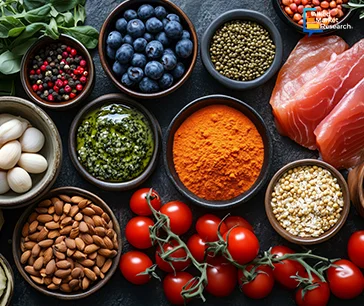Table Of Contents
- The shift toward precision wellness and personalized nutrition helping the sector flourish
- Growing consumption of plant-based and alternative proteins creating favorable conditions for growth
- The rise in demand for fusion flavors impacting the industry positively
- Increased adoption of sustainable packaging improving the revenue share of the domain
- Development of functional and nutrient-dense foods accelerating the sectoral growth
- In essence

Roshan Deshmukh

Koyel Ghosh
AMR’s Analysis: Key Trends Transforming the Food and Beverages Industry in Q1 2025

In the last few decades, especially after the COVID-19 pandemic, the awareness regarding immunity building, balanced diet, and healthy lifestyle has grown drastically. People are increasingly opting for food items that improve their overall well-being, thus opening new avenues in the food and beverages domain. Moreover, the rising demand for vegan products has played an important role in influencing the growth of the sector. In addition, advancements in packaging and investments in logistics and supply chain management have brought in numerous profitable opportunities. Furthermore, the increased consumption of packaged and frozen foods and the surge in the number of e-commerce platforms selling groceries and other retail items has maximized the revenue share of the domain. This newsletter analyzes all such major factors, trends, and developments in the food and beverages sector that have impacted the landscape positively in the first quarter of 2025.
The shift toward precision wellness and personalized nutrition helping the sector flourish
Unlike traditional treatment mechanisms that are reactive, precision wellness adopts a more proactive and targeted approach wherein the patient’s medical history, lifestyle, genetic makeup, and environment are considered to offer a holistic health plan. Medical practitioners are gradually transitioning toward personalized nutrition and precision wellness techniques to address the complicated healthcare needs of their patients. Experts in medical science emphasize that personalized and precision medicine is essential today, given the vast differences in people's consumption habits, sleep patterns, metabolic rates, and genetic predispositions worldwide.

The personalized nutrition market accounted for $14.6 billion in 2021 and is anticipated to gather a revenue of $37.3 billion by 2030, rising at a CAGR of 11.48% during 2022-2030. The increasing integration of advanced technologies such as AI and machine learning has widened the scope of the industry in the first quarter of 2025. Moreover, the growing use of IoT-powered smart wearables has enabled doctors to monitor the medical condition of their patients in real-time, thus enhancing the quality of diagnosis and treatment significantly. Additionally, the data collected through these devices is analyzed using ML algorithms to predict the issues a patient is likely to face in the near future and recommend drugs and medications accordingly.
Growing consumption of plant-based and alternative proteins creating favorable conditions for growth
Traditionally, meat and other animal-based products have been the primary source of proteins for humans. However, several environmental studies have shown that poultry businesses are some of the biggest contributors to carbon emissions in the global economy. Moreover, a rise in animal rights activism has elevated the demand for plant-based products significantly. As a result, the consumption of alternative protein sources has surged drastically in the first quarter of 2025. In addition, the rising pace of urbanization has increased the disposable incomes of people living in metropolitan cities and industrial towns. Hence, despite being expensive compared to meat products, these plant-based food items have become quite popular in urban areas.

The heavy investments by leading food and beverage industries in the plant-based meat market have increased its revenue share in Q1 2025. The industry, which accounted for $5.3 billion in 2021, is predicted to gather a revenue of $33.3 billion by 2031, rising at a CAGR of 20.5% during 2022-2031. Over the years, several wholesalers, retailers, and agents have partnered with food product manufacturers to launch alternative protein supplements. The main advantage of these collaborations is that they have helped companies distribute their products globally, thus expanding their customer base.
The rise in demand for fusion flavors impacting the industry positively
In the last few years, the idea of fusion cuisines has become quite popular in several countries across the globe. It refers to a style of cooking that involves blending different ingredients, culinary styles and traditions, and food preparation techniques of different regions and cultures. The increasing pace of globalization and the rising number of tourists and travelers has further augmented the demand for such recipes and dishes. Consequently, the sale of both synthetic and natural fusion flavors has surged considerably in Q1 2025.
The use of herbs and spices such as basil, chili pepper, and cilantro has grown significantly in European and American dishes. Additionally, technological advancements in the food flavor market have played an important role in broadening the scope of the sector. Leading enterprises have developed innovative techniques to simplify processes associated with flavor synthesis, extraction, and encapsulation. Moreover, the regulatory frameworks established by different governments to supervise the manufacturing of different additives, spices, and condiments have influenced the growth of the landscape of fusion flavors in the first quarter of 2024. The food flavor industry, which accounted for $14.8 billion in 2023, is anticipated to gather a sum of $23.8 billion by 2033, citing a CAGR of 4.9% during 2024-2033.
Increased adoption of sustainable packaging improving the revenue share of the domain
The food and beverage sector has been one of the biggest users of plastics and polymer packaging materials, thus contributing to global warming and climate change. However, in the last few years, the growing environmental consciousness has compelled businesses to shift to eco-friendly packaging solutions to reduce the carbon footprint of their operations in the long run. The decreasing dependence on plastic products is expected to help the sustainable packaging market gather a revenue of $190.6 billion by 2031. The landscape accounted for $93.6 billion in 2021, rising at a CAGR of 7.4% during 2022-2031.

Over the years, people around the world have started opting for food and beverage items that are packaged in biodegradable and lightweight materials. To address these evolving demands, companies such as Emerald Packaging, Sonoco Products Company, Tetra Pak, Kappa Group PLC, and Sealed Air Corporation have started shifting to green solutions that have minimal impact on the global ecosystem and biodiversity. Additionally, e-commerce platforms, too, have started delivering groceries and other food products in compostable packaging materials, thereby decarbonizing the sector.
Development of functional and nutrient-dense foods accelerating the sectoral growth
Functional foods are processed foods that provide health benefits beyond their nutritional value, thus facilitating a reduction in disease risk. The primary reason behind the growing preference for such products is their ability to address different nutritional deficiencies. Moreover, certain functional foods that are rich in omega-3 fatty acids help reduce the possibility of lifestyle diseases such as heart ailments, diabetes, cancer, stroke, etc. Technological advancements in ingredient formulation and food processing have helped the functional food industry gather a revenue of $237.8 billion by 2033. The market was valued at $172.6 billion in 2023 and is projected to grow at a CAGR of 3.4% during 2024-2033. The increasing awareness regarding immunity development, fitness, and healthy eating has played an important role in the growth of the landscape in the first quarter of 2025.

In essence
The expansion of the food and beverages domain in Q1 2025 is attributed to increasing demand for personalized nutrition and functional beverages. The shift toward sustainable packaging and the surge in consumption of plant-based products has created new investment opportunities in the landscape. Additionally, the growing popularity of fusion flavors is expected to augment the growth rate of the sector in the coming period. Furthermore, technological advancements in food processing and packaging are anticipated to help the domain increase its revenue share substantially in the near future.
For tips and recommendations on how to capitalize on the investment opportunities in the food and beverages industry, feel free to talk to our industry analysts today!

